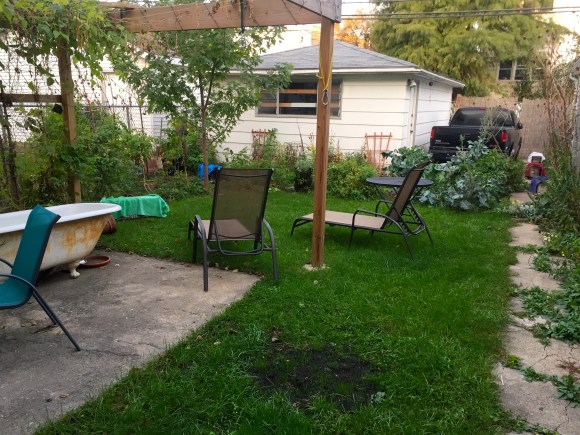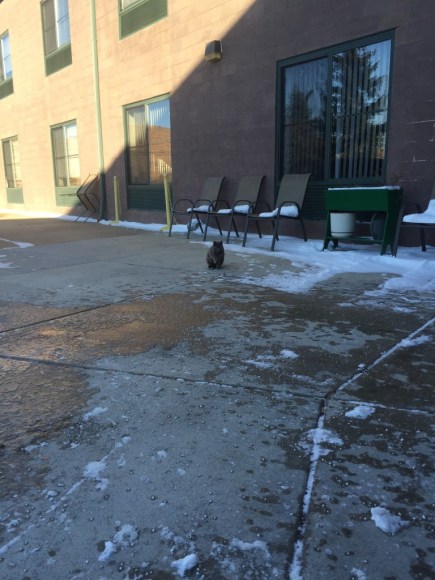Introducing the Charlie Chaplin Colony: In Honor of Melanie and Her Cat, Lumpy
Melanie emailed me mid-October looking for help for the cats on her block in Avondale. When I looked up her address I knew we HAD to help her – she lived just a few blocks from my rescue partner, Kim, and three other colonies we did this summer: the Big Daddy Colony, the Polska Kittens Colony, and the Wild Wild West Colony. Coincidence? Nope. This area has a huge cat overpopulation problem but it can be contained with diligent, consistent TNR and colony management. We’re already well on our way. About 30% of the cats we trapped this summer from here were admitted into no-kill shelters.
Melanie estimated were 7-10 cats coming to her yard, but she knew there could be more. She also knew there was a mama cat and kittens, because they visited at one point recently. That means the kittens were just weaned. When she inquired about the costs, Melanie offered to sponsor any care as needed. She just lost her beloved pet cat, Lumpy, very recently, and wanted to continue the care of the outdoor cats in her honor.
Just look at beautiful Lumpy. As Melanie explained, “Not to brag, but she was the funniest, chattiest, softest, best beast on the entire planet. Sigh. I miss her terribly. And yes, she would always sit like this. The best!” We agree! She was gorgeous!

Melanie told Kim and I that an elderly Polish neighbor left cat food every morning in her front yard, which is why the cats were congregating their in the first place.
We asked her to communicate as best as she could with everyone to stop feeding the cats for a day or two. She didn’t know who the Polish lady was,… yet. When we arrived as planned at 5am on a Friday morning, we saw the food on her front steps.

We threw out the food, and set up the traps regardless. Melanie has a beautiful yard and garden, perfect for the cats to hang out and hide in. And perfect to keep traps hidden in.
We set up traps in her front yard.

And we set up traps in her back yard.


While we were setting up traps in her back yard, we heard the ones in the front yard snapping shut immediately.
TNR was ON.
We trapped five cats that day. Cats started visiting from all around us.
This one came by to hang out under my car. Yup, we got her.

We set up a Cats In My Yard sign on Melanie’s front gate to explain to everyone what we were doing. It’s translated in Spanish and Polish. We saw A LOT of people stopping to read the sign. Everyone was into it and gave us the thumbs up after reading it, or asked us more questions. It’s a great way to spread awareness of your TNR project in the neighborhood.

All of the neighbors were into what we were doing, and we have plans to trap in their yards. The elderly Polish feeder came by, and agreed to stop feeding for the weekend. She is also going to show us all of the other places that she feeds cats!
The next day we set up traps again at 5am and got another four cats. At this point we had nine cats trapped for TNR.
During that time, a little cat came wobbling up to us. Clearly something was wrong with her because she was walking very funny, and we were lucky to trap her. I’ll write more about her and her injuries later.
Melanie also trapped the mama cat and found her four kittens in a garage down the street from her with the help of neighbors. I’ll also be writing about the kittens more later.
The whole weekend the cats stayed in my garage in their traps in preparation for PAWS Chicago’s low-cost TNR clinic.

The next day we were ready to bring the healthy adult cats to PAWS. That morning Melanie trapped one last cat, so there were now a total of eleven cats going there. Jim helped us out with transport.
All eleven of these cats were TNR’d, then recovered at Kim’s house, and returned to Melanie’s yard.
Katler is the gorgeous mama cat, whose kittens are now in foster care for eventual admission into PAWS.

Big Tux Jackson is the big male eleventh cat who was trapped at the eleventh hour at the last minute.

Tommy Two Ears is a fairly friendly male cat who lost most of his ears from fighting, frost bite, or who knows what from being on the streets. We’ll be keeping an eye on him to see if he’s interested in being in an indoor home – it’s hard to tell for now.

Chinny is another male cat that seems fairly friendly. We tested him for FIV/FeLV, and he was negative. We’ll also be keeping an eye on him to see if he’s interested in being adopted into a new permanent indoor home.

Inky 1 is a black male cat, identical to his brothers, Inky 2 and Inky 3. Fun fact: he loves to shred newspapers into tiny pieces, hiss and lunge whenever he can, and emits bathroom deposits in impressively huge quantities. Cleaning his trap while he was in it was quite a comedic endeavor.

The funny part was Melanie was well aware that there are three black cats. She just named them all of the same.
Melanie thought there was one tabby cat, but little did she know there were two.
Here’s Wee Tab, a female brown tabby.

And Alt Tab, her female brown tabby sister or doppelgänger.

Then check out Big Skinny, a male grey tabby.

And Little Skinny, a female torbie. Fun fact: this girl ate more than anyone.

In the meantime, Melanie purchased a few outdoor shelters from Kim for her yard to help the TNReturned colony cats stay warm in the winter, and set up a permanent feeding station in her front yard.
We are excited to continue TNR with Melanie and all of her neighbors on the block. Working with such kind neighbors is a dream come true when you are doing TNR.
I’ll also be updating soon about what is happening with the four kittens and injured cat. We also know there are more cats out there from this colony. Please contact us if you’d like to help, 773-609-CATS (2287) or [email protected]
Or donate through the Paypal button at the top of this page or through [email protected]









































































